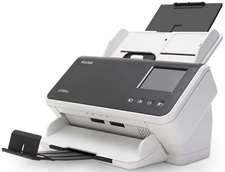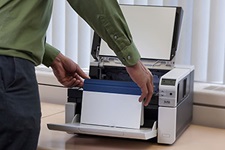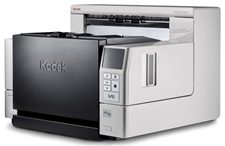Paperless Pharmacy Processes Benefits
Paperless Pharmacy Processes and Their Benefits
Organizations across all industries can benefit from going paperless, but in the pharmaceutical industry, digitization takes on higher stakes. With at least 1.6 million preventable medication errors occurring every year, going paperless is not just about saving resources, time, and money, but also about promoting patients’ health and safety.
Let’s take a look at some of the paperless processes already in use in pharmacies across the globe and how they’re benefiting pharmacists and patients alike.
Pharmacy workflows often begin with the writing of a prescription.
Most people can probably remember having received a handwritten prescription from their doctor, but paper prescriptions have long been on their way out. This change began in 2003 with the passing of the Medicare Prescription Drug, which encouraged providers and pharmacists to voluntarily use electronic prescribing (or e-prescribing).
Individual states have since begun passing their laws regarding electronic prescriptions. By 2015, e-prescribing for controlled substances was legal in all 50 U.S. states, and half of all states will soon make e-prescribing for controlled substances a requirement.
This most recent push for e-prescribing is an attempt to combat the opioid epidemic by reducing prescription drug theft, forgery, and transferring. A 2014 study also found that e-prescribing increases efficiency, as pharmacists don’t have to manually enter or scan the prescription information, and reduces prescribing errors and health care costs.
Around 60% of prescriptions are now sent electronically, although the method of sending them varies. Some electronic prescriptions are sent as part of a stand-alone system, such as by emailing or faxing, but many are now integrated within pharmacies’ comprehensive electronic health record systems.
Paperless Pharmacy Management Systems
Once a prescription arrives at a pharmacy, numerous operations are necessary for the pharmacist to fulfill the prescription accurately, efficiently, and according to regulatory compliance requirements. Many pharmacies are now using paperless pharmacy management systems to streamline these operations and more.
Pharmacy management systems vary in terms of the functions they include and how they work, but they generally offer:
- Workflow and inventory management
- Prescription processing
- Claims reconciliation
- Prescription auto-fills
- Accounts receivable processing
- Medicare and commercial insurance sourcing
- Patient medication adherence solutions
- Medication synchronization solutions
- Electronic prior authorization solutions
- Automated third-party benefit coordination
- Safety checking and prescription verifications
- Point-of-sale functionality
- Pharmacy-patient communication tools
The best pharmacy management systems can even be integrated into existing electronic health record (EHR) systems, allowing pharmacists to access patient information as inputted by their medical providers.
Digitizing all of these pharmacy processes creates countless benefits. Perhaps most important is the increased accountability and safety when it comes to ensuring that patients receive the correct prescriptions and dosages, as well as the convenience patients, enjoy by being able to receive notifications and renew prescriptions electronically.
Electronic pharmacy workflows are also more organized, effective, and efficient, as pharmacists have instant access to all the information they need without having to search for it. Additionally, pharmacies save significant space when they no longer have to store insurance, patient, and other information in physical copies on-site. Protected health information (PHI) is also easier to secure when digital, and pharmacists don’t have to worry about shredding confidential documents that no longer need to be retained.
Related: How HIPAA Affects Medical Records Scanning
Paperless Medication Education
After being written by doctors and fulfilled by pharmacists, prescriptions eventually go home in the hands of patients, and this last step presents the most room for improvement when it comes to going paperless.
State Boards of Pharmacies require that pharmacies provide patients with medication information for every prescription dispensed. While many pharmacies assume that this information must be provided in paper form, no such requirement exists — providing medication information in a digital format is equally viable.
Pharmacies would do well to consider switching to a digital format, not only because of the obvious benefits of saving paper (and money on paper) but also because paper-based medication information doesn't promote health literacy. The average printed medication education leaflet only provides around 50% of the information necessary for a patient to use a medication accurately, according to the FDA. And much of that information doesn’t get across anyway, as 79% of patients in a Journal of General Internal Medicine study misunderstood at least one of the 10 common prescription label instructions they were presented with.
Of course, none of that matters if the patients don’t read the education sheets in the first place, and research has shown that less than 25% of patients do. Most pharmacists are acutely aware of how many patients toss the paper in the trash on their way out of the pharmacy, or decline to take it at all.
Fortunately, better options exist with digital education tools. One option has the patient use their smartphone to scan the QR code on their prescription, which in turn brings up the normal medication education content plus easy-to-understand educational videos. All pharmacists have to do is give patients the choice of switching.
Such a simple switch helps pharmacists cut back on paper usage and drastically improves patients’ health literacy, in turn preventing nonadherence issues such as nursing home admissions, hospitalizations, and even premature deaths.
Take Your Pharmacy Paperless
Pharmacies that haven’t done so already clearly have much to gain from going paperless, starting with paperless prescriptions and ending with paperless medication information. Getting started involves investing in the right equipment and software, including a fax machine, a pharmacy management system, and digital education tools.
Of course, pharmacies just starting to go paperless will also have to convert existing paperwork to digital formats, and all pharmacies will have to handle the inevitable paper document that appears from time to time. For these tasks, an effective document scanner will be necessary.
Kodak Alaris offers scanning solutions to meet all of a pharmacy’s document scanning needs while adhering to the strict regulations of the industry. Our scanners have been tested and certified by all major electronic medical record (EMR) vendors and meet all health care and pharmaceutical compliance requirements, including HIPAA, Meaningful Use, and HL7.
Hundreds of healthcare providers across the U.S. are already using Alaris scanners to go paperless. Contact us to learn more and join them.
Insights and Case Studies
How HIPAA Affects Medical Records Scanning
By Kara Rayburn, Global Manager, Product Marketing & WebHIPAA was enacted to ensure privacy and security of patient information. As the healthcare industry is going paperless, find out how scanning plays a role.
Related solutions

S2060w Scanner
60 ppm | Automatyczny podajnik dokumentów na 80 arkuszy- Wydajne i łatwe do udostępniania skanowanie sieci
- Wbudowane przetwarzanie obrazu
- Utwórz do 20 stanowisk pracy w każdym dziale
- Podwójne oświetlenie (DLI)

i3450 Scanner
- Up to 90 ppm color/ bw, A3 scanner
- Integrated book-edge A4 flatbed for exception documents

i4850 Scanner
160 ppm | Automatyczny podajnik dokumentów na 500 arkuszy- Nasz najszybszy kompaktowy skaner produkcyjny
- Intuicyjny kolorowy ekran o przekątnej 3,5 cala (89 mm)
- Surepath™ inteligentna technologia podawania dokumentów
- Cyfrowe i amp; fizyczne opcje nadruku
Related Challenges
ABOUT THE ALARIS DIVISION OF KODAK ALARIS
Kodak Alaris is a leading provider of information capture and intelligent document processing solutions that simplify business processes. We exist to help the world make sense of information with smart, connected solutions powered by decades of image science innovation. Our award-winning software, scanners, and professional services are available worldwide and through our network of channel partners.
Partners
Privacy Notice | Legal / Site Terms | California Notice at Collection | Do Not Share My Personal Information
© 2024 Kodak Alaris Inc. TM/MC/MR: Alaris, ScanMate. All trademarks and trade names used are property of their respective holders. The Kodak trademark and trade dress are used under license from Eastman Kodak Company.
